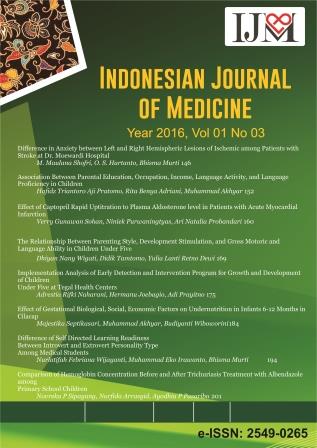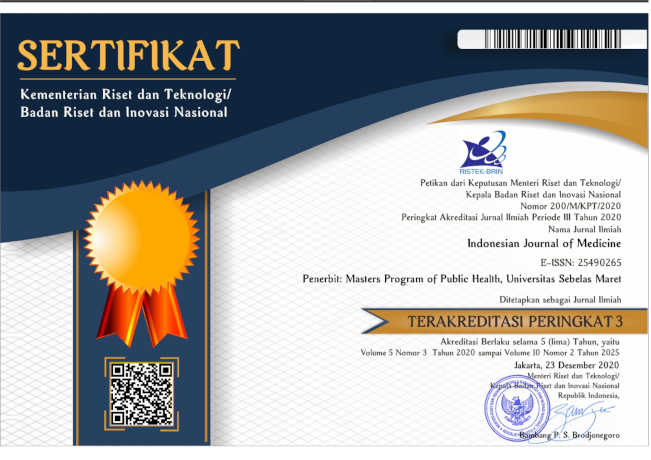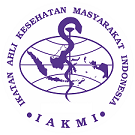Difference in Anxiety between Left and Right Hemispheric Lesions of Ischemia among Patients with Stroke at Dr. Moewardi Hospital
DOI:
https://doi.org/10.26911/theijmed.2016.1.3.24Abstract
Background: The difference of lesion location and anxiety usually manifests into different signs and symptomps based on the patient’s lesion location. This study aimed to determine the difference in anxiety between left and right hemispheric lesions of ischemia among patients with stroke.
Subjects and Method: This was an analytic observational study with cross sectional design. A total sample of 30 patients with stroke consisting of 15 patients with left hemisphere lesion and 15 patients with right hemisphere lesion of ischemia was selected by random sampling. Anxiety was assessed using Hamilton Rating Scale for Anxiety (HRSA) questionnaire. The data were analyzed by multiple linear regression.
Results: After controlling for family supports as confounding factor, this study showed significantly lower anxiety in patients with left hemispheric lesion ischemia than patients right hemispheric lesion (b= -2.77; p = 0.039). Family support lessened anxiety among patients with stroke (b=-5.21; p=0.003).
Conclusion: Anxiety in stroke patients with left hemispheric lesion of ischemia is lower than stroke patients with right hemispheric lesion.
Keywords: anxiety, ischemic stroke, left hemispheric lesion, right hemispheric lesion
Correspondence: M. Maulana Shofri. Faculty of Medicine, Sebelas Maret University, Surakarta.
Indonesian Journal of Medicine (2016), 1(3): 146-151
https://doi.org/10.26911/theijmed.2016.01.03.01
References
Aliah A, Kuswara FF, Limoa RA, Wuysang G (2007). General overview of brain blood circulation Disorders (GPDO). In: Harsono 2nd edition: Capita Selecta Neurology. Yogyakarta: Gadjah Mada University Press 81-102.
Astrom M, Asplund K (2005). Handicap and quality of life after stroke. In: Bogousslavsky J (ed). Long term effects of stroke. New York: Marcel Dekker, Inc 25-48.
Bethesda Stroke Center (2007). Six Steps Handling Stroke. http optimal handling://www.Strokebethesda.comcontent/view/152/42/. Accessed January 2013.
Bousser MG (2008). Relation between migraine and stroke. The Lancet Neurology 4: 533-542.
Bruggimann L, annoni JM, Staub F, von Steinbu¨chel N, Van der Linden M, Bogousslavsky J (2006). Chronic Post traumatic Stress Symptoms after stroke no severe. Neurology, 66, 513-516. doi: 10.1212/01.wnl.000019-4210.98757.49
Coonley T (2006). Breaking Free from the Anxiety Trap. http://www.wshg.org. uk. Accessed January 2013.
Duncan (2000). Prognostic value of blood pressure when the patient entered the hospital in pain in patients with acute infarction stroke.
Erhan H, Ochâo E, Borod J, Feinberg T (2000). Consequences of right cerebrovasculer accident on emotional functioning: diagnostic and treatment implication. CNS Spectr 5(3): 25-38.
Feigin VL, Lawes CM, Bennett DA, Anderson CS (2003). Stroke epidemiology: A review of population-based studies of the incidence, prevalence, and case fatality in the late 20th century. Lancet Neurology 2: 43-53.
Hawari D (2006). Management of Stress, Anxiety, and Depression. Jakarta: Balai FKUI Publishers 130-132.
Kusuma Y, Venketasubramanian N, Kiemas LS, Misbach J (2009). Burden of stroke in Indonesia. International Journal of Stroke 4(5): 379-380.
Juan de JL, Adolfo V, Otman F, Juan CL, Rudbeskia P, Ana ML, Beatriz M (2010). Prevalence of stroke and associated risk factors in older adults in the city and Matanzas provinces havana, cuba (10/66 population based study). MEDICC Review 12(3): 20-26.
Lumbantobing SM (2011). Stroke. In: Neurogeriatri. Jakarta: FK UI Hall Publishers 93-134.
Nusantara Medical Center (2009). Stroke attack otak.http://www.nusantaramc.com/highlightsdetail.php? Id= 6. Accessed February 2013.
Opara JA, Jaracz K (2010). quality of life of post stroke Patients and their care givers. Journal of Medicine and Life 3(3): 216-220.
Robinson RG, Starr LB, Kubos KL (2006). A two year longitudinal study of poststroke mood disorder: findings during the initial evaluation. stroke; Journal of the American Heart Association 14: 736-741.
Smet KG (2004). Social support survey. Journal of social science and Medicine 32: 705-706.
Tarasova M, Nečasová J, Mikulík R, Pohanka M, Hashim MKA, Drliková L, Bartlova B (2007). Quality of Life in Patients after acute stroke.Scripta Medica (BRNO) 80(5): 243-252.
Trismiati (2004). Anxiety level differences between male and female contraception acceptor steady at Hospital Dr. Sardjito. Journal Psyche 1(1).
Toole (2000). Prognostic value of blood pressure when the patient was hospitalized in acute infarction stroke. B.NeuroSains 1(3): 161-162.
World Health Organization (2006).The WHO stepwise approach to stroke surveillance.
Worp HB, Gijn J (2007). Acute ischemic stroke. N Engl J Med 357: 572-579.












